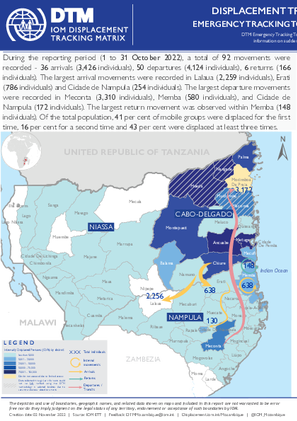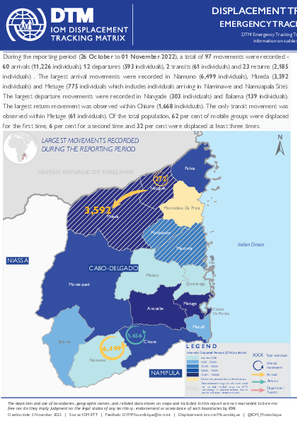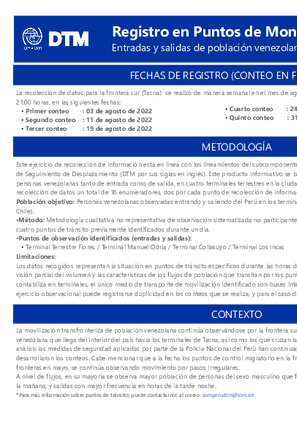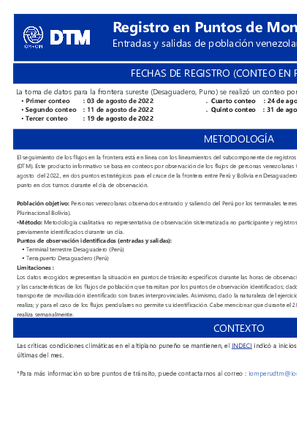-
Countries
-
Data and Analysis
-
Special Focus
-
Crisis Responses

Contact
DTM Somalia, IOMSomaliaDTM@iom.int
Language
English
Location
Somalia
Period Covered
Oct 15 2022
Oct 19 2022
Activity
- Mobility Tracking
- Event Tracking
Since November 2021, 313,618 individuals have been displaced by drought in Gedo region. Since round 32, an estimated 5,937 IDPs arrived at the assessed settlements.

Contact
DTMMozambique@iom.int
Language
English
Location
Mozambique
Period Covered
Oct 01 2022
Oct 31 2022
Activity
- Mobility Tracking
- Event Tracking
During the reporting period (1 to 31 October 2022), a total of 92 movements were recorded - 36 arrivals (3,426 individuals), 50 departures (4,124 individuals), 6 returns (166 individuals). The largest arrival movements were recorded in Lalaua (2,259 individuals), Erati (786 individuals) and Cidade de Nampula (254 individuals).
The largest departure movements were recorded in Meconta (3,310 individuals), Memba (580 individuals), and Cidade de
Nampula (172 individuals). The largest return movement was observed within Memba (148 individuals). Of the total population, 41 per cent of mobile groups were displaced for the first time, 16 per cent for a second time and 43 per cent were displaced at least three times.

Contact
DTM Nigeria, AllUsersInDTMNigeria@iom.int
Language
English
Location
Nigeria
Period Covered
Oct 24 2022
Oct 30 2022
Activity
- Mobility Tracking
- Event Tracking
The DTM Emergency Tracking Tool (ETT) is deployed to track and to collect information on large and sudden population movements, provide frequent updates on the scale of displacement and quantify the affected population when needed. As a sub-component of the Mobility Tracking methodology in Nigeria, ETT utilises direct observation and a broad network of key informants to capture best estimates of the affected population per location, enabling targeted humanitarian response planning.
Between 24 and 30 October 2022, a total of 1,097 new arrivals were recorded in locations in Adamawa and Borno States. The new arrivals were recorded at locations in Askira/Uba, Bama, Dikwa, Damboa, Gwoza, Kala Balge, Monguno and Ngala Local Government Areas (LGAs) of the most conflict-affected state of Borno and in Fufore, Gombi, Girei, Hong, Lamurde, Michika, Maiha, Mubi South, Song, Yola North and Yola South LGAs of Adamawa State.

Contact
DTMMozambique@iom.int
Language
English
Location
Mozambique
Period Covered
Oct 26 2022
Nov 01 2022
Activity
- Mobility Tracking
- Event Tracking
During the reporting period (26 October to 01 November 2022), a total of 97 movements were recorded - 60 arrivals (11,226 individuals), 12 departures (593 individuals), 2 transits (61 individuals) and 23 returns (2,185 individuals) . The largest arrival movements were recorded in Namuno (6,499 individuals), Mueda (3,592 individuals) and Metuge (775 individuals which includes individuals arriving in Naminawe and Namuapala Site).
The largest departure movements were recorded in Nangade (303 individuals) and Balama (139 individuals). The largest return movement was observed within Chiure (1,668 individuals). The only transit movement was observed within Metuge (61 individuals). Of the total population, 62 per cent of mobile groups were displaced for the first time, 6 per cent for a second time and 32 per cent were displaced at least three times.
Contact
iombeirut@iom.int
Location
Lebanon
Activity
- Migrants presence
- Mobility Tracking
- Baseline Assessment
Period Covered
May 01 2022 -Jul 31 2022
The MPM assessment follows the methodology of IOM’s global Displacement Tracking Matrix (DTM) Mobility Tracking component. Tailored to the operational context in Lebanon, the MPM assessment analyzes data to provide multi-layered information on the presence and mobility of migrants. This assessment aims to complement existing data collection exercises and it is implemented in coordination with key actors to maximize synergies, interoperability and avoid duplication.
In the second round of the MPM survey, an estimated 135,420 migrants were identified, compared to 207,696 in 2021, indicating a 35% decrease in the number of migrants. These migrants primarily reside in urban areas, with Mount Lebanon (56%) and the Beirut governorate (18%) reporting the highest proportions of the identified migrant population.
During this rounf, 2,337 neighborhoods across 26 districts and 8 governorates were covered. Surveys for 1,598 cadasters were completed, which amounts to a coverage of 99.3% of all cadasters in Lebanon.
The majority of migrants identified in Lebanon come from Ethiopia (37%), Bangladesh (22%), and Sudan (8%). Among the migrants, 76% are female, while 26% are male. It's worth noting that the female-to-male ratio varies by nationality, with 99% of Ethiopians and 97% of Filipinos being female, while only 24% of Egyptians and 26% of Sudanese are female.
Population Groups
Survey Methodology
Unit of Analysis Or Observation
Type of Survey or Assessment
Keywords
Geographical Scope
Administrative boundaries with available data
The current dataset covers the following administrative boundaries

Contact
DTMcovid19@iom.int
Language
English
Location
Global
Period Covered
Oct 24 2022
Oct 31 2022
Activity
- Other
The DTM Global Mobility Restrictions Overview provides updates on international air travel restrictions and conditions for authorized entry. This overview aims to understand how COVID-19 has impacted human mobility, detailing how global and regional trends in air travel measures have evolved since COVID-19 was declared a global pandemic in March 2020. The data presented focuses on the changes in public health-related immigration and border management measures. It provides information intended to support IOM missions and partners in targeted response planning and advocacy for vulnerable populations who may be affected by changes in global mobility.

Contact
REMAPBD@iom.int, rdhroap@iom.int, dtmremapsupport@iom.int
Language
English
Location
Bangladesh
Snapshot Date
Dec 31 2021
Activity
- Other
This snapshot report on remittance inflows to Bangladesh during COVID-19 is part of IOM's EU-funded project Displacement Tracking Matrix - Regional Evidence for Migration Analysis and Policy (DTM) and the Asia Pacific Regional Data Hub (RDH). The inflow of remittances is one of the main driving forces in Bangladesh’s economic growth and development (IOM, 2021b). Remittances support the economy by increasing foreign exchange reserves and national savings, and reducing poverty levels (Chowdhury and Chakraborty, 2021). As a result of the COVID-19 global crisis and the decrease in overseas Bangladeshi migrant workers, the inflow of remittances to the country was initially predicted to decline significantly in 2020 (ADB, 2020; World Bank, 2020a). However, contrary to all negative forecasts, recorded remittance inflows to Bangladesh remained resilient (IOM, 2021a; IOM, 2022).

Contact
DTM Peru, IOMDTMPeru@iom.int
Language
Spanish
Location
Peru
Period Covered
Aug 03 2022
Aug 31 2022
Activity
- Flow Monitoring
Este ejercicio de recolección de información está en línea con los lineamientos del subcomponente de monitoreo de flujos de la metodología de la Matriz de Seguimiento de Desplazamiento (DTM por sus siglas en inglés). Este producto informativo se basa en conteos por observación de los flujos de personas venezolanas tanto de entrada como de salida, en cuatro terminales terrestres en la ciudad de Tacna. En este conteo participaron en la recolección de datos un total de 16 enumeradores, dos por cada punto de recolección de información, en dos turnos durante el día de observación. Población objetivo: Personas venezolanas observadas entrando y saliendo del Perú en los terminales terrestres de la ciudad de Tacna (frontera con Chile).

Contact
DTM Peru, IOMDTMPeru@iom.int
Language
Spanish
Location
Peru
Period Covered
Aug 03 2022
Aug 31 2022
Activity
- Flow Monitoring
El seguimiento de los flujos en la frontera está en línea con los lineamientos del subcomponente de registros de la metodología de Matriz de Seguimiento de Desplazamiento (DTM). Este producto informativo se basa en conteos por observación de los flujos de personas venezolanas tanto de entrada como de salida, realizados el 3,11, 19, 24 y 31 de agosto del 2022, en dos puntos estratégicos para el cruce de la frontera entre Perú y Bolivia en Desaguadero. Para este conteo participaron ocho enumeradores, dos por cada punto en dos turnos durante el día de observación.

Contact
Arnin Cortez Morales arncortez@iom.int
Language
Spanish
Location
Nicaragua
Period Covered
Apr 01 2022
Jul 31 2022
Activity
- Survey
- Community Perception
- Flow Monitoring
El presente estudio tiene como objetivo general: Identificar las necesidades comunitarias en el casco urbano de Bilwi y las comunidades de Karata, Wawa Bar y Haulover enfocadas en la movilidad humana, resiliencia climática, recuperación de medios de vida, y protección sensible al género, mediante la implementación de la herramienta denominada Matriz de Seguimiento de Desplazamiento (DTM) en el contexto posterior a los huracanes Eta e Iota.
Este estudio es cuantitativo, descriptivo y exploratorio, de corte transversal debido a que se realiza en un solo período de tiempo, comprendido entre abril a julio de 2022. La metodología es una adaptación de la DTM, mediante tres instrumentos de recolección de datos: una encuesta de viviendas, encuesta de línea de base del seguimiento de la movilidad y monitoreo de flujos migratorios; y una encuesta de hogares/personas migrantes o familiares de migrantes que permitiera la elaboración de un perfil de migrantes.